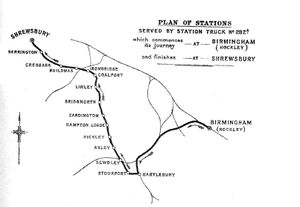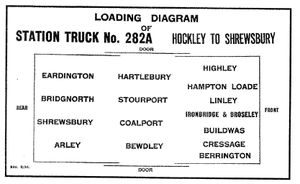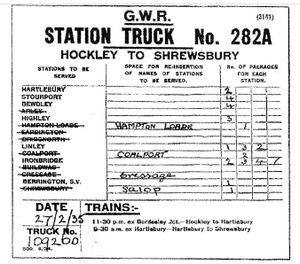Station Truck
The April 1935 issue of the Great Western Railway magazine carried an article on the use of Station Trucks using the Severn Valley Railway as an example. The following text and pictures are copied from the magazine.
"The 'Station Truck' is a goods vehicle which is sent off on a journey from one defined part of the line to another to discharge and pick up goods at stations along the route. More than 600 Station Trucks operate daily.
The trucks pick up and convey goods from smaller stations to transhipment depots, where the goods are transferred to other trucks for despatch and unloading at their destinations.
The Station Trucks are a means of giving 'next morning' delivery of goods to small stations far away from their source of supply. In the case of Paddington, over fifty wagons are sent out each night with goods for hundreds of small stations around the system. For example one truck will leave by express freight train just with deliveries for Gwinear Road, Praze, Nancegollen, and Helston, while another will be despatched to Sarnau, St Clears, Clynderwen, Clarbeston Road and other stations in West Wales.
Every Station Truck works to a pre-determined regular schedule and its stops are pre-arranged. A special label is printed for each truck, the one illustrated is for goods to and from the Hockley Transhipment Depot to stations on the Severn Valley Line, or for goods from one station to another on the line, in which case they do not go to Hockley for transhipment. The label shows all the stations being called at and shows the position of goods in the truck for each station. It is obvious that goods need to be easily found or confusion and delay will arise. The positions are such that consignments for say the first station are not covered or made inaccessible by items for stations further along the line. In addition, to ensure that all the packages are unloaded as required there is a printed Station Truck Label which lists all the stations to be called at. The members of staff responsible for unloading the truck are able to see from the label how many articles are for their station. When the truck is loaded any station with no goods for delivery is crossed out. However, if some goods is loaded en-route for that station further along the line there is space to re-enter the station name. There are also columns for filling in the number of packages for delivery at each station. Again, if any packages are added, these additional packages are listed in the extra columns. In the example shown the truck left Hockley with one package for Linley, but a further three were added at one station and two at another. When the truck arrives at Li.nley the staff will look for six packages at the front centre of thetruck. At Bridgnorth the staff will see that their station name has been crossed off and not re-entered en route so will not find any goods for delivery there.
At Shrewsbury the Station. Truck Label will be retained for reference. It: may be that adjustments will be made depending on the quantity of goods being carried. A return truck from. Shrewsbury to Hockley (now numbered 282B) will also run picking up goods for delivery to stations on the Severn Valley Line and for further afield by transhipment at Hockley."


